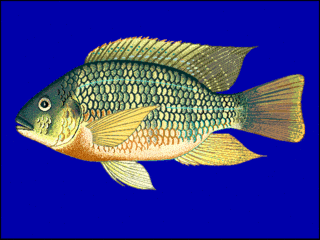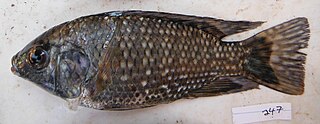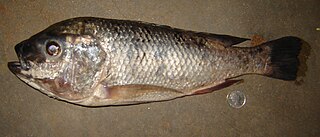
A genetically modified organism (GMO) is any organism whose genetic material has been altered using genetic engineering techniques. The exact definition of a genetically modified organism and what constitutes genetic engineering varies, with the most common being an organism altered in a way that "does not occur naturally by mating and/or natural recombination". A wide variety of organisms have been genetically modified (GM), from animals to plants and microorganisms. Genes have been transferred within the same species, across species, and even across kingdoms. New genes can be introduced, or endogenous genes can be enhanced, altered, or knocked out.

Tilapia is the common name for nearly a hundred species of cichlid fish from the coelotilapine, coptodonine, heterotilapine, oreochromine, pelmatolapiine, and tilapiine tribes, with the economically most important species placed in the Coptodonini and Oreochromini. Tilapia are mainly freshwater fish inhabiting shallow streams, ponds, rivers, and lakes, and less commonly found living in brackish water. Historically, they have been of major importance in artisanal fishing in Africa, and they are of increasing importance in aquaculture and aquaponics. Tilapia can become a problematic invasive species in new warm-water habitats such as Australia, whether deliberately or accidentally introduced, but generally not in temperate climates due to their inability to survive in cold water.

Molecular genetics is a sub-field of biology that addresses how differences in the structures or expression of DNA molecules manifests as variation among organisms. Molecular genetics often applies an "investigative approach" to determine the structure and/or function of genes in an organism's genome using genetic screens. The field of study is based on the merging of several sub-fields in biology: classical Mendelian inheritance, cellular biology, molecular biology, biochemistry, and biotechnology. Researchers search for mutations in a gene or induce mutations in a gene to link a gene sequence to a specific phenotype. Molecular genetics is a powerful methodology for linking mutations to genetic conditions that may aid the search for treatments/cures for various genetics diseases.

The Nile tilapia is a species of tilapia, a cichlid fish native to the northern half of Africa and the Levante area, including Palestine, and Lebanon. Numerous introduced populations exist outside its natural range. It is also commercially known as mango fish, nilotica, or boulti. The first name leads to easy confusion with another tilapia which is traded commercially, the mango tilapia.

Oreochromis is a large genus of oreochromine cichlids, fishes endemic to Africa and the Middle East. A few species from this genus have been introduced far outside their native range and are important in aquaculture. Many others have very small ranges; some are seriously threatened, and O. ismailiaensis and O. lidole possibly are extinct. Although Oreochromis primarily are freshwater fish of rivers, lakes and similar habitats, several species can also thrive in brackish waters and some even survive in hypersaline conditions with a salinity that far surpasses that of seawater. In addition to overfishing and habitat loss, some of the more localized species are threatened by the introduction of other, more widespread Oreochromis species into their ranges. This is because they—in addition to competing for the local resources—often are able to hybridize.
A transgene is a gene that has been transferred naturally, or by any of a number of genetic engineering techniques from one organism to another. The introduction of a transgene, in a process known as transgenesis, has the potential to change the phenotype of an organism. Transgene describes a segment of DNA containing a gene sequence that has been isolated from one organism and is introduced into a different organism. This non-native segment of DNA may either retain the ability to produce RNA or protein in the transgenic organism or alter the normal function of the transgenic organism's genetic code. In general, the DNA is incorporated into the organism's germ line. For example, in higher vertebrates this can be accomplished by injecting the foreign DNA into the nucleus of a fertilized ovum. This technique is routinely used to introduce human disease genes or other genes of interest into strains of laboratory mice to study the function or pathology involved with that particular gene.

Gene delivery is the process of introducing foreign genetic material, such as DNA or RNA, into host cells. Gene delivery must reach the genome of the host cell to induce gene expression. Successful gene delivery requires the foreign gene delivery to remain stable within the host cell and can either integrate into the genome or replicate independently of it. This requires foreign DNA to be synthesized as part of a vector, which is designed to enter the desired host cell and deliver the transgene to that cell's genome. Vectors utilized as the method for gene delivery can be divided into two categories, recombinant viruses and synthetic vectors.

Tilapia has become the third most important fish in aquaculture after carp and salmon; worldwide production exceeded 1.5 million metric tons in 2002 and increases annually. Because of their high protein content, large size, rapid growth, and palatability, a number of coptodonine and oreochromine cichlids—specifically, various species of Coptodon, Oreochromis, and Sarotherodon—are the focus of major aquaculture efforts.
Throughout much of the tropics, tilapiine cichlids native to Africa and the Levant have been widely introduced into a variety of aquatic systems. In the U.S. states of Florida and Texas, tilapia were originally introduced to curtail invasive plants. In an effort to meet the growing demand for tilapia, humans have farmed these fish in countries around the world. Capable of establishing themselves into new ponds and waterways, many tilapia have escaped aquaculture facilities across much of Asia, Africa, and South America. In other cases, tilapia have been established into new aquatic habitats via aquarists or ornamental fish farmers.

The Mozambique tilapia is an oreochromine cichlid fish native to southeastern Africa. Dull colored, the Mozambique tilapia often lives up to a decade in its native habitats. It is a popular fish for aquaculture. Due to human introductions, it is now found in many tropical and subtropical habitats around the globe, where it can become an invasive species because of its robust nature. These same features make it a good species for aquaculture because it readily adapts to new situations. It is known as black tilapia in Colombia and as blue kurper in South Africa.

A transplastomic plant is a genetically modified plant in which genes are inactivated, modified or new foreign genes are inserted into the DNA of plastids like the chloroplast instead of nuclear DNA.

Oreochromis leucostictus is a species of cichlid native to Albertine Rift Valley lakes and associated rivers in DR Congo and Uganda. It has now been introduced widely elsewhere East Africa, and is believed to have negative ecological impact, particularly on native tilapias. This species is reported to reach a standard length of up to 36.3 cm (14.3 in), but is usually much smaller. It is exploited by small-scale fishery and aquaculture operations.

Oreochromis lidole is a species of freshwater fish in the family Cichlidae. This tilapia is native to Malawi, Mozambique and Tanzania, where it is found in Lake Malawi, Lake Malombe, the Shire River and perhaps some crater lakes further north. It is important in fisheries, but has drastically declined; it may already be extinct. This oreochromine cichlid is locally called chambo, a name also used for two other closely related species found in the same region, O. karongae and O. squamipinnis.
Genetic pollution is a controversial term for uncontrolled gene flow into wild populations. It is defined as "the dispersal of contaminated altered genes from genetically engineered organisms to natural organisms, esp. by cross-pollination", but has come to be used in some broader ways. It is related to the population genetics concept of gene flow, and genetic rescue, which is genetic material intentionally introduced to increase the fitness of a population. It is called genetic pollution when it negatively impacts on the fitness of a population, such as through outbreeding depression and the introduction of unwanted phenotypes which can lead to extinction.

A genetically modified mouse or genetically engineered mouse model (GEMM) is a mouse that has had its genome altered through the use of genetic engineering techniques. Genetically modified mice are commonly used for research or as animal models of human diseases, and are also used for research on genes. Together with patient-derived xenografts (PDXs), GEMMs are the most common in vivo models in cancer research. Both approaches are considered complementary and may be used to recapitulate different aspects of disease. GEMMs are also of great interest for drug development, as they facilitate target validation and the study of response, resistance, toxicity and pharmacodynamics.

Genetically modified animals are animals that have been genetically modified for a variety of purposes including producing drugs, enhancing yields, increasing resistance to disease, etc. The vast majority of genetically modified animals are at the research stage while the number close to entering the market remains small.

Genetically modified fish are organisms from the taxonomic clade which includes the classes Agnatha, Chondrichthyes and Osteichthyes whose genetic material (DNA) has been altered using genetic engineering techniques. In most cases, the aim is to introduce a new trait to the fish which does not occur naturally in the species, i.e. transgenesis.

Genetic engineering can be accomplished using multiple techniques. There are a number of steps that are followed before a genetically modified organism (GMO) is created. Genetic engineers must first choose what gene they wish to insert, modify, or delete. The gene must then be isolated and incorporated, along with other genetic elements, into a suitable vector. This vector is then used to insert the gene into the host genome, creating a transgenic or edited organism. The ability to genetically engineer organisms is built on years of research and discovery on how genes function and how we can manipulate them. Important advances included the discovery of restriction enzymes and DNA ligases and the development of polymerase chain reaction and sequencing.
Breast cancer metastatic mouse models are experimental approaches in which mice are genetically manipulated to develop a mammary tumor leading to distant focal lesions of mammary epithelium created by metastasis. Mammary cancers in mice can be caused by genetic mutations that have been identified in human cancer. This means models can be generated based upon molecular lesions consistent with the human disease.
Q-system is a genetic tool that allows to express transgenes in a living organism. Originally the Q-system was developed for use in the vinegar fly Drosophila melanogaster, and was rapidly adapted for use in cultured mammalian cells, zebrafish, worms and mosquitoes. The Q-system utilizes genes from the qa cluster of the bread fungus Neurospora crassa, and consists of four components: the transcriptional activator (QF/QF2/QF2w), the enhancer QUAS, the repressor QS, and the chemical de-repressor quinic acid. Similarly to GAL4/UAS and LexA/LexAop, the Q-system is a binary expression system that allows to express reporters or effectors in a defined subpopulation of cells with the purpose of visualising these cells or altering their function. In addition, GAL4/UAS, LexA/LexAop and the Q-system function independently of each other and can be used simultaneously to achieve a desired pattern of reporter expression, or to express several reporters in different subsets of cells.











